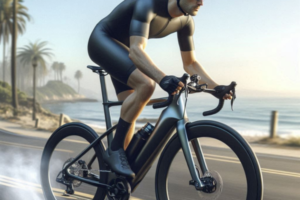Battery maintenance humid environments electric bicycles is not just a seasonal concern — it’s a year-round necessity for riders in coastal cities and tropical climates. While electric bicycles offer an eco-friendly and efficient way to move through traffic and enjoy scenic waterfronts, they also bring with them a vulnerable core: the lithium-ion battery. 🌊🔋
In humid regions like Cartagena, Key West, or Singapore, where the air constantly carries moisture and salt, the health of your e-bike battery can deteriorate silently. Most riders know to avoid deep puddles or avoid charging a wet battery, but few realize how constant exposure to humidity affects performance even without visible damage. Moisture in the air is invisible — but its consequences are not. ⚠️
Your e-bike’s battery is more than just a power source; it’s an investment. And in places where average humidity exceeds 60%, this investment is under quiet, continuous attack. From internal condensation to corrosion at the terminals, the threats come from the inside out. Riders who don’t take preventive measures risk more than reduced range — they risk fire hazards, system failures, and costly replacements. 💸🔥
🌬️ Why Humid Coastal Air Is Especially Dangerous
Humidity acts like a slow-working toxin on electric bicycle batteries. In coastal cities, moisture is often mixed with salt particles that linger in the air. These particles settle inside vents, around ports, and even on the protective casing itself. Over time, the repeated exposure to this moist environment can breach seals, degrade insulation, and compromise internal cell chemistry. 🌫️⚡
And it doesn’t take a flood or tropical storm for damage to occur. Something as simple as storing your e-bike in a garage without ventilation, or charging it after a misty morning ride, can lead to internal condensation. Lithium-ion cells are sensitive to both temperature shifts and water vapor. When the protective barrier fails, degradation begins from within. 🧪
🔎 How Battery Maintenance Affects E-Bike Longevity in Humid Conditions
Whether you’re commuting along the beach, exploring coastal parks, or navigating tropical downtowns, understanding the specific impact of humidity is the first step to preventing it. Battery wear in wet conditions often shows up subtly at first:
- ⚠️ A drop in range despite full charges
- ⚠️ Battery overheating during mild use
- ⚠️ Visible rust on connectors or mounting points
- ⚠️ Soft buzzing or warmth during charging
Unfortunately, by the time these symptoms appear, the battery has already suffered internal stress. That’s why battery maintenance humid environments electric bicycles should begin before any problem arises. Prevention is always less expensive — and safer — than repair. 🛡️🔍
💬 Rider Insight: “I used to keep my e-bike on my covered balcony. It never got rained on — but after a year, my battery started failing. It turns out the salt air and night humidity were enough to corrode the terminals. Now I store it indoors, and I’ve doubled my battery’s life.” — Miguel, rider in San Juan, Puerto Rico
This example is common across riders in coastal zones. You don’t have to see water for it to be present. And with battery costs ranging from 20% to 40% of the total e-bike value, protective maintenance is not optional — it’s essential. In the next blocks, we’ll explore how to store, clean, charge, and ride in a way that defends your battery against humidity — and keeps your journey safe and efficient. 🌦️🚴♂️
In the world of battery maintenance humid environments electric bicycles, proper storage is one of the most powerful defenses against moisture-related degradation. Even with an IP-rated battery and weather-resistant frame, constant exposure to coastal humidity can find its way into seams, ports, and pressure points — silently chipping away at your battery’s health. 🛡️🌦️
Many riders assume their battery is “safe” just because it’s not soaked. But in coastal cities, ambient air moisture alone can lead to corrosion, internal condensation, and even electric leakage over time. Where and how you store your battery directly impacts its longevity. That’s why having the right strategy for storage in humid climates is crucial. 📦🔋
📊 Comparative Table: Battery Storage Practices in Humid Coastal Settings
| Storage Method | Humidity Protection | Battery Lifespan Impact | Recommended? |
|---|---|---|---|
| Garage Shelf (no ventilation) | Low | High degradation over time | ❌ |
| Indoor Closet (no airflow) | Moderate | Some condensation risk | ⚠️ |
| Ventilated Room with Dehumidifier | High | Maximized battery protection | ✅ |
| Storage Bag with Silica Gel Packs | High | Minimized corrosion risks | ✅ |
As the table shows, storage in a ventilated indoor environment or using dehumidifying methods significantly improves battery health. When you’re living near the sea, moisture control must go beyond avoiding puddles — it starts at home. 🏠🌫️
🏠 Storage Habits That Save Your Battery
- ✅ Always store the battery off the ground — floors trap moisture and fluctuate in temperature more than shelves.
- ✅ Keep the battery in a room with active airflow — a ceiling fan or window can help reduce stagnant humidity.
- ✅ Avoid sealed plastic containers — unless you add desiccant packs to absorb trapped moisture.
- ✅ Use microfiber cloths to wipe down the battery after every ride, especially if you rode near saltwater or mist.
Many coastal riders make the mistake of thinking “indoor” means “safe.” But if your indoor storage lacks ventilation or is placed near laundry areas, air conditioning units, or exposed pipes, your battery could still be breathing in humidity. 💨⚠️
💬 Real Example: “I thought my hallway closet was the safest spot for battery storage, but when I opened it one day, everything was damp inside. Since moving it to a ventilated room with a small fan, I’ve had zero moisture issues.” — Luisa, commuter in Recife, Brazil
When it comes to battery maintenance humid environments electric bicycles, the difference between early replacement and five years of smooth use often comes down to where you leave your battery at night. Smart storage is your first line of defense — and one of the cheapest. 🧠🔋
Battery maintenance humid environments electric bicycles isn’t just about storage — it’s about creating smart routines for daily use. In coastal cities, even short rides can expose your battery to moisture, salt, and thermal fluctuations that degrade performance if left unchecked. 🧠🌊
The challenge? Most riders don’t realize their habits — like plugging in a warm, damp battery or washing their bike with too much water pressure — are slowly shortening battery life. That’s why adopting clear, repeatable care routines is essential for anyone riding through fog, rain, or tropical air. ⚡🛠️
🧾 Daily and Weekly Battery Care Checklist for Humid Conditions
- ✅ Dry before charging: Always inspect your battery for external moisture before plugging it in. Use a microfiber cloth to wipe down the case and connectors.
- ✅ Cool before connecting: After riding in warm, humid air, allow your battery to cool and normalize to room temperature before charging. This prevents internal condensation.
- ✅ Elevate the charger: Don’t place your charger directly on the floor, especially in basements or outdoor sheds. Humid air settles low and can affect both charger and battery.
- ✅ Use original chargers: Manufacturer-approved chargers are designed to match your battery’s thermal profile and are less likely to overheat or malfunction in damp air.
- ✅ Inspect terminal areas weekly: Look for rust, discoloration, or fog buildup around connection points. A soft toothbrush and dielectric grease can clean and protect these areas.
- ✅ Limit pressure washing: Clean your bike with low water pressure. Never aim water directly at the battery casing or connectors.
- ✅ Ventilate during charging: Always charge your battery in a dry, ventilated room. This avoids the buildup of heat and moisture that can trigger early aging.
These practices may sound basic, but when repeated consistently, they form a barrier between your battery and the harshness of the coastal climate. 🧽🌬️
⚠️ Charging Mistakes to Avoid in Humid Cities
Humidity makes even a simple task like charging more dangerous if not handled carefully. Moisture near ports can cause short circuits or permanent damage. The combination of salt particles and heat — especially in beach cities — becomes a silent catalyst for internal decay. 🚫🔌
Common mistakes include:
- ❌ Charging a battery directly after a rainy ride
- ❌ Leaving batteries on concrete floors where humidity pools
- ❌ Using third-party chargers in garages without airflow
- ❌ Forgetting to inspect terminals for corrosion build-up
All of these habits, over time, create the perfect storm for reduced battery performance — or worse, failure. That’s why prevention beats repair every time. 🛡️💡
💬 Real Story: “I thought I had a faulty charger until I noticed tiny rust spots inside the battery connector. I started using dielectric grease and drying it after every foggy ride. It hasn’t failed since.” — Rodrigo, e-bike courier in Guayaquil
Battery maintenance humid environments electric bicycles becomes easier when routines are established. You don’t need expensive tools or advanced knowledge — just awareness, consistency, and a willingness to treat your battery like the high-performance asset it truly is. ⚙️🌧️
Even the most diligent riders can overlook key aspects of battery maintenance humid environments electric bicycles when transporting their bikes, storing batteries for long periods, or simply leaving them idle in high-humidity homes. In coastal regions, these oversights quietly erode your battery’s lifespan. 🌧️🔋
Transporting your e-bike or storing the battery off the frame presents unique risks. Sudden shifts in temperature (like moving from a cold car trunk to a warm home) create internal condensation. Sealed containers, though well-intentioned, can trap humidity. Without active moisture control, even short trips or seasonal storage can lead to long-term degradation. 🚗💧
📦 Smart Transport Tips for Batteries in Humid Climates
- ✅ Wrap batteries in a dry, breathable towel or cloth before transport. This prevents moisture from condensing directly on the case.
- ✅ Avoid storing batteries in sealed plastic containers unless desiccant packs are included. Trapped humidity is worse than airflow.
- ✅ Don’t leave your battery inside a hot car for extended periods — especially in coastal parking lots with both heat and salt air.
- ✅ Let batteries acclimate to indoor temperatures before charging after long transport or storage. This prevents internal vapor buildup.
- ✅ If traveling by air or sea, use padded, vented battery bags designed for lithium-ion transport.
These practices don’t just prevent corrosion — they also reduce fire risk, which increases when lithium-ion packs experience thermal shock or hidden moisture while under charge. 🔥🧊
🛡️ Are Battery Covers Worth It in Humid Regions?
Absolutely. Riders in coastal cities benefit enormously from using protective battery covers. These sleeves — typically made from neoprene or silicone — do more than repel water. They regulate temperature, block salt particles, and reduce exposure to direct sun and rain. ☀️🌊
Look for features like:
- 🧵 Breathable yet water-resistant materials
- 🌡️ Insulation to stabilize temperature extremes
- 🧼 Easy-clean surfaces to remove salt and road grime
- 🔒 Secure fit to avoid vibration during rides
Combined with regular cleaning, battery covers extend the lifespan of both your casing and internal components — and in humid air, that adds months or even years of useful battery life. 🛞💪
🔎 Visual Inspections and Early Diagnostics
Regular visual checks are a frontline defense against humidity damage. Many riders wait until their battery underperforms before inspecting it — but by then, corrosion may already be advanced. Create a simple weekly routine focused on three areas:
- 🔌 Terminals: Look for rust, discoloration, or residue buildup
- 🔧 Casing: Inspect for cracks, swelling, or warping of seals
- 📐 Mounting area: Check for puddled water or damp grime around contact points
If your battery features Bluetooth connectivity or digital diagnostics, use the app to review cell temperatures and charging behavior. Sudden drops in capacity or heat spikes are early signs of internal moisture exposure. 📲📊
💬 Community Tip: “I added a calendar reminder every Sunday to check my battery case and terminals. It takes five minutes, and last month I caught a tiny crack before it became a problem.” — Natalia, coastal e-bike rider in Lima, Peru
🌬️ Controlling Indoor Humidity Where You Store Batteries
Many riders assume that storing their battery indoors protects it completely. But in humid coastal homes — especially those without climate control — moisture still lingers in closets, laundry rooms, and even bedrooms. Here’s how to create a safer space:
- ✅ Use a small dehumidifier where your battery is stored. Target a relative humidity below 60%.
- ✅ Place silica gel packs near the battery (but not in contact with terminals).
- ✅ Avoid placing the battery on cold floors or near air vents where condensation can occur.
- ✅ Choose insulated, breathable storage bags for off-season protection.
Battery maintenance humid environments electric bicycles isn’t just about daily riding — it’s about protecting your investment around the clock. With better transport practices, smart coverings, and weekly diagnostics, you’ll keep your battery healthy long after others start losing capacity. 🔋🧠
At the core of battery maintenance humid environments electric bicycles is a simple truth: consistency creates longevity. While humid climates introduce unique challenges, they also empower riders to become more intentional, more aware, and more connected to their e-bike’s true needs. 🌀🔋
By embracing a proactive mindset, you shift from reacting to battery problems to preventing them. This doesn’t require expensive tools or advanced training — just small, habitual actions done daily, weekly, and seasonally. And the result? A battery that performs better, lasts longer, and keeps your journey running smoothly — rain or shine. 🌧️☀️
✅ Final Maintenance Checklist for Humid Climates
- ✅ Store your battery in a ventilated room with humidity below 60%
- ✅ Always wipe the battery and ports before charging
- ✅ Never charge in damp garages or on wet floors
- ✅ Inspect terminals weekly for rust, swelling, or residue
- ✅ Use dielectric grease to protect metal connectors
- ✅ Apply breathable, water-repellent battery covers for riding and storage
- ✅ Keep charging logs or use diagnostic apps for ongoing monitoring
Each of these steps helps create a system of care that reinforces battery health in the face of the coastal elements. It’s not about perfection — it’s about protection. 🛡️🌬️
🌟 Thought to Ride With: “You can’t stop the ocean air — but you can ride prepared for it. Discipline today is durability tomorrow.”
❓ Frequently Asked Questions (FAQs)
Does high humidity really affect battery lifespan?
Yes. Prolonged exposure to humid air can cause internal condensation, corrosion at terminals, and reduced lithium-ion efficiency — especially in coastal cities.
What’s the best way to store an e-bike battery long-term in a humid climate?
Use a ventilated indoor space, keep the battery off the floor, and include moisture-absorbing silica gel or a dehumidifier nearby.
Can I use a battery cover while charging?
No. Battery covers are for riding and storage only. Always remove them during charging to avoid heat buildup.
How often should I clean my battery connectors?
Once a week in coastal zones, or after any wet or foggy ride. Use a soft brush and apply dielectric grease when necessary.
What’s the cost benefit of better battery care?
Proper maintenance can extend battery life from 2 to 5 years, saving up to 40% of the bike’s replacement cost and reducing electronic waste.
💬 Join the Coastal E-Bike Community
Are you riding in a humid or coastal city? Have you discovered your own tricks for preserving your e-bike battery through rainy seasons and salty winds? Then you’re exactly the kind of rider we want to hear from. 🌴💙
Leave a comment. Share your storage setup. Recommend your favorite battery cover. Or just say where you ride and how you keep your bike powered and protected. Every insight you offer helps others ride smarter, farther, and safer. 🚴♀️🛞
📣 Community Call: What’s one habit that’s helped your battery survive the coastal climate? Share it below — your advice might extend someone’s next ride by miles.
Thank you for being part of this journey. 💙 Your battery is your e-bike’s heartbeat — treat it with care, and it will take you farther than you imagined, through every breeze and every storm. 🌬️🔋



